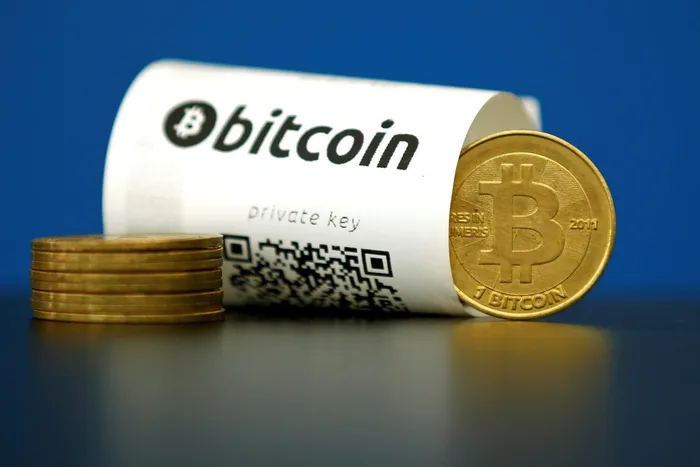Global crypto payment acceptance surges past Visa, Mastercard
CRYPTO

Bitcoin. No longer a niche, crypto payments have demonstrably cleared a critical mass, with stablecoin adoption and usage outpacing traditional payment services in many regions.
Image: Reuters
The crypto payment landscape has crossed the chasm, surging past early adoption into the mainstream of global commerce as US dollar (USD)-backed stablecoins out-performed Visa and Mastercard in all four quarters of last year and continued their dominance in Q1 2025.
No longer a niche, crypto payments have demonstrably cleared a critical mass, with stablecoin adoption and usage outpacing traditional payment services in many regions.
According to a report by crypto exchange CEX.IO, global stablecoin transfers reached $27.6 trillion in 2024, outpacing Visa and Mastercard’s combined transaction volume by 7.68%,
In response, both Visa and Mastercard are rolling out stablecoin services to get a share of the payment action.
Mastercard recently partnered with MoonPay to enable stablecoin payments across 150 million merchants, which follows earlier deals with OKX, Nuvei, and Circle, while Visa is piloting stablecoin services in six Latin American countries.
This means acceptance of blockchain-based digital assets as a legitimate means of exchange is not only growing; it has already hit the mainstream.
Other service providers like Bitpay are also enabling wider adoption. The cryptocurrency payment processing company has 250,000 large customers that accept crypto, with leading global companies such as Microsoft, Burger King, adidas, AT&T, and PayPal having integrated cryptocurrencies into their payment systems, enabling consumers to use the asset class for everyday transactions.
Interestingly, the rates of adoption and usage of cryptocurrency as a means of exchange are growing fastest outside the developed world.
According to Chainalysis's 2024 Global Adoption Index, the Central and Southern Asia and Oceania (CSAO) region leads the world in terms of global cryptocurrency adoption, with seven of the top 20 countries located in the area.
The report also found that decentralised finance (DeFi) services increased significantly in Sub-Saharan Africa, with South Africa emerging as a major hub for cryptocurrency payments within the retail sector in 2024.
The use of cryptocurrency as a payment method is gaining momentum in South Africa following two significant developments.
Pick n Pay, one of the country’s largest supermarket chains, announced a partnership with MoneyBadger to begin accepting Bitcoin payments at over 2,200 stores nationwide, enabling customers to pay for daily essentials with the cryptocurrency stored in a range of Bitcoin wallets.
More recently, a prominent crypto exchange integrated with Zapper, allowing users to make seamless cryptocurrency payments at a growing number of retailers.
This development marks a significant step in South Africa’s embrace of digital assets, further bridging the gap between cryptocurrency and everyday commerce.
According to MoneyBadger stats, South Africa's crypto users per capita are among the highest globally at 12%, ranking the country 14th globally in cryptocurrency payment acceptance.
Payment acceptance is growing as the integrated ecosystem around blockchain-based digital assets evolves in lockstep with progressive regulatory reforms and licensing from the Financial Sector Conduct Authority (FSCA), which has approved the use case.
The FSCA officially declared crypto assets as a financial product in terms of the Financial Advisory and Intermediary Services Act (FAIS) in October 2022.
The Bitcoin Lightning network enables instant, secure, low-cost Bitcoin transactions that happen faster than bank transactions, with credit card payments often taking a day to clear.
Retailers can also save on the merchant fees and costs that come with accepting credit cards, explains Olivier, as the economies of scale achieved on the Lightening Network or either second-layer applications or side chains support more transactions on a single contract, effectively reducing fees.
As more players enter the market, fees will come down further as the decentralised nature of cryptocurrency payments do not require interbank settlement, and the customer pays some part of the transaction cost.
In addition, a retailer can get cost-effective and near-instant clearance when accepting crypto payments on the Lightening Network or other side chains or second-layer applications.
The ability for large retailers to receive the payment faster has massive implications for the business, shifting cash flow from a month-to-month to a day-to-day basis.
This value proposition is compelling for retailers. However, while there are more major retailers adopting cryptocurrency as a valid form of payment, we need to see mass adoption to achieve the scale necessary to drive the network effect and spur usage.
A major challenge creating a sticking point for mass adoption is consumers' unwillingness to part with their cryptocurrency.
There are 5.8 million South Africans who own cryptocurrency, suggests data from the South African Revenue Service (SARS), with a Statista Market Forecast predicting that this number will reach 6.05 million by the end of 2024, with $388.3 million in unspent cryptocurrency assets.
However, the average consumer is not using cryptocurrency as a means of exchange. Instead, they view cryptocurrencies as an investment opportunity or store of value.
While crypto was initially designed to facilitate secure decentralised peer-to-peer (P2P) payments, it has since evolved into a speculative asset class with the rise of crypto exchanges and the exponential rise in cryptocurrency values.
The key to boosting usage is shifting consumers from this speculative mindset, but this cannot happen if retailers wait for usage to increase. We need to see more widespread acceptance by more big-name physical and e-commerce retailers to realise the network effect that will start driving usage and promote spending from consumers.
The local industry has the ecosystem in place to support mass adoption by retailers and usage by consumers.
While concerns exist around crypto payment integration into ERP systems due to the complexity this can introduce, the industry has the skills and expertise to make this happen.
Businesses can also access advice and solutions to hedge against cryptocurrency volatility, ensuring every eventuality is covered, whether they want to accept crypto payments as a valid form of tender, which is converted instantly to fiat currency, or retain the cryptocurrency on balance sheet.
Wiehann Olivier, a Partner and FinTech & Digital Assets Lead and Dinesh Gurlal Director, IT Assurance at Forvis Mazars in South Africa.

Dinesh Gurlal Director, IT Assurance at Forvis Mazars in South Africa
Image: Supplied.

Wiehann Olivier, a Partner and FinTech & Digital Assets Lead
Image: Supplied.
BUSINESS REPORT
Visit: www.businessreport.co.za